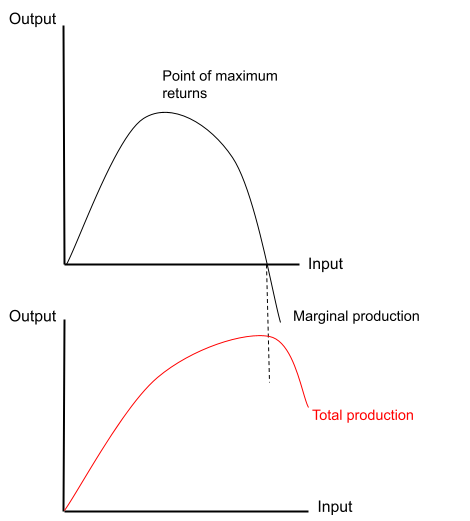Point of Diminishing Returns
A point that follows when the optimal production level is reached, where every additional input unit yields a lower increase in the total output.
What is the Point of Diminishing Returns?
The point of diminishing returns is a point that follows when the optimal production level is reached, where every additional input unit yields a lower increase in the total output.
The law of diminishing returns, also known as the law of diminishing marginal returns, is a concept in microeconomics.
It states that in a production process, in the short run, when increasing a variable factor of production to other fixed factors, marginal productivity increases initially but starts to decrease after reaching a certain optimal production level.
The only way to achieve optimal productivity is to increase or change different aspects of factors of production.
This idea dates back to the 1700s and is believed to have first been articulated by classical economists Thomas Malthus and David Ricardo.
Ricardo was the first to express how adding labor and capital to a fixed piece of land would result in a minor output increase.
Malthus also introduced the idea while constructing his population theory, which argues that population growth and food production increase but at different rates, resulting in the population outgrowing its food supply - which all leads back to diminishing returns.
Early application of this theory went into farming, but with modernized times, this started shifting into factories and industries that all witnessed technological advancements.
Key Takeaways
- The point of diminishing returns states that adding an extra unit of a factor of production yields smaller increases in outputs.
- After reaching the optimal production level, any additional unit of a production factor added decreases marginal production while keeping other production factors constant.
- It can be identified by taking the second derivative of the production function.
- The law of diminishing returns, also known as marginal returns, can only be observed in production processes and only takes place in the short run.
- It allows firms to identify the ideal number of inputs they should add to achieve optimal production.
- It has three stages: increasing marginal returns, maximum marginal returns, and diminishing marginal returns.
- Total production is maximized when the marginal product is zero.
Understanding diminishing returns
Diminishing returns expresses a moment when increasing the number of a factor of production, while the rest are held constant, doesn't always increase productivity.
After reaching an optimal point of production, it yields a slower increase in output until it eventually starts to decrease output overall.
To further understand this concept, let's consider a simplified example.
Let us consider an area of land, one worker, one truck, and some equipment. This worker can supply three houses using the existing daily factors, but what happens when labor increases?
| Number of workers (Input) | Number of houses (Total production) | Marginal product |
|---|---|---|
| 1 | 3 | 3 |
| 2 | 10 | 7 |
| 3 | 15 | 5 |
| 4 | 20 | 5 |
| 5 | 23 | 3 |
| 6 | 25 | 2 |
| 7 | 26 | 1 |
| 8 | 26 | 0 |
| 9 | 24 | -2 |

According to the data above, we see that as labor, a variable factor of production, increases, the production of houses increases as well but at what rate?
When employees hit 3-4, the rate of house production starts to diminish with every additional employee. This is because only the number of employees is being changed.
TP keeps increasing but slowly, whereas MP starts to fall following the optimal needed number of labor (3).
Once MP reaches zero, TP is at its highest (26 houses). Conversely, when MP yields a negative result, TP starts decreasing.
At a certain point, adding an extra unit of a factor of production results in a relatively minor increase in outputs due to inefficiency.
In this case, productivity can be increased by distributing labor and adding more trucks and equipment.
This data can be expressed on a graph as:

Based on the graphs above, we see that MP increases and reaches a maximum point as the number of labor increases; following that, it starts to fall until it reaches below zero.
On the other hand, the TP curve starts as a steady increase following each additional labor and reaches its peak when the MP curve is at zero; once MP falls below zero, TP starts to decrease.
Characteristics of the law of diminishing returns
Diminishing returns is a phenomenon that occurs and leads to businesses becoming less productive; that's because, past a certain point, efficiency starts to decrease.
Some factors that characterize this phenomenon are:
- It happens only in the short run - that is because, in the short run, most of the factors of production are fixed (ex: land and capital). But in the long run, all factors are variable.
- There is no technological advancement - the production process stays the same; otherwise, it can improve production efficiency.
- It only occurs in production functions.
- The units of variable factors of production are homogeneous - meaning an additional unit in labor, for example, will be equally skilled as the existing labor.
- Lower productivity level - it can be counterproductive to add additional workers past a certain point.
A way to help avoid such an event of diminishing marginal returns would be to introduce technological advancements and increase other factors of production as well.
In other words, pay attention to the number of outputs made from different combinations of inputs and choose the best combination of inputs that yields the desired output level at the lowest cost.
How to calculate the point of diminishing returns
The point of diminishing returns refers to an inflection point of a return function and can be calculated by taking the second derivative of the return function.
Example 1:
A company uses the model


To relate to its revenue, R in millions to x in millions spent on advertising. Find the point of diminishing returns.


The inflection point is located where the second derivative equals 0 or undefined, so
→ 30 - 3x = 0
→ 30 = 3x
→ 10 = x
So the point of diminishing return is at $10 million. This means that at $10 million, the rate of revenue increases due to advertisement and starts to slow.
Example 2:
A company uses the model

To relate its revenue, R, in thousands of dollars, to the amount of money spent on advertisements. Find the point of diminishing returns.
The model can be expressed as,



The infliction point is located where the second derivative equals 0 or undefined, so

We multiply each side by 10000 to cancel it out, so
600 - 6x = 0
600 = 6x
x = 100
So the point of diminishing return is at $100 thousand.
The three stages of diminishing returns
Once a firm starts producing a diminishing return, this means that one or several factors of production aren't being used efficiently; a unit of input is being oversupplied.
This can be further expressed in a graph:

Based on the graph above, we can see the curve's steepness starting; this can be due to adding additional input units, say labor, for example.
Afterward, the curve reaches a maximum point of return, expressing the maximum number of inputs that should be added to achieve optimal production.
Finally, marginal production starts to decrease, meaning that the additional unit of inputs, in this case, labor, isn't helping production efficiently.
So we can sum up the stages in,
- Increasing marginal returns - this is expressed as the steep curve at the start. As inputs (labor) are added, production and output increase consequently.
- Maximum marginal returns - expressed as point X on the graph. The maximum point of production is reached due to the addition of labor.
- Diminishing marginal returns - expressed as the downward-sloping curve following point X. As we continue adding the labor, MP decreases because it is no longer efficient.
Furthermore, as labor continues to be added, in this case, MP will continue to decrease until it falls to 0. Once it falls below 0, total production starts to decrease overall.
Importance of the law of diminishing returns
The law of diminishing returns helps businesses in management and decision-making in areas such as how much input to add to their production process.
This is critical because it allows firms to identify where an additional unit starts to create additional costs rather than benefits.
This law also helps firms maximize their profits and minimize costs, allowing them to identify the optimal combination of inputs to increase production efficiency.
It informs business owners of the point where they can generate the maximum output while minimizing costs.
Also helps owners identify when to expand their factor of production and when to introduce technological advancements, such as machinery that can be more efficient in the production process.
Overall, this theory helps lower costs and aims at improving efficiency by pinpointing a point where production afterward would not yield an optimal output.
Point of diminishing returns in everyday life
This theory can be applied in several ways in our everyday lives, but a simplified real-world example could be a supermarket.
Consider a supermarket needing various staff members to carry on functions from stacking and arranging, to assisting customers, to checking out and several other tasks.
A specific number of employees will be needed to carry on and run the place while yielding optimal profits.
Below that number of employees, our business is understaffed. As a result, customers aren't getting the best service due to the small number of helpers and, consequently, end up frustrated.
As we hire additional help, the supermarket's MP rises because labor productivity increases and specialization takes place; each employee handles a specific area in the home and is responsible for it.
There is also underutilization of fixed factors of production, meaning there is enough workspace for employees to work together.
We then reach a point where the supermarket yields optimal output - meaning we've hired the maximum number of employees needed to run the place before MP decreases.
For some reason, we continue hiring more employees; what happens next?
The store starts becoming overstaffed, and employees surround customers to assist them. Still, most of these employees could go long without speaking to a customer and stand around due to the increasing employee-to-customer ratio.
This shows how chaotic the store is getting and how inefficient it is becoming, and labor productivity starts to decrease due to the fixed factors of production becoming a constraint.
In this case, the only way to maintain the store's efficiency would be to expand the system overall, expand the store, and start getting more customers.









or Want to Sign up with your social account?